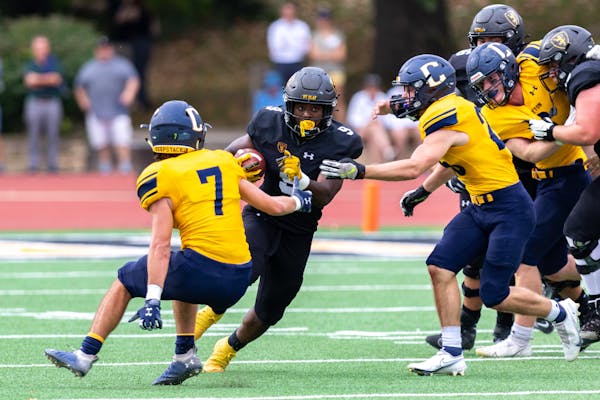Whatever question there was about St. Thomas football being able to move from Division III to Division I, that's no longer the discussion.
The question isn't whether St. Thomas can survive in the Pioneer League, it's whether the Tommies can challenge for the conference title.
On Saturday, they face Pioneer League member Marist, which has the longest-tenured head coach in Division I football, Jim Parady. In his 30th season, he'll be facing the Tommies for the first time.
"This was the first week I really looked at their film as we were preparing for it. I have to tell you I was not really happy because they were so good on film," Parady said. "I didn't expect them to be as good as what popped off the film. I said that to my wife … 'Geez, I was hoping they wouldn't be this good.' "
Marist is tied with the Tommies at 3-1 in conference play, one game behind leaders Davidson and Morehead State at 4-0. Parady understands what St. Thomas has gone through in making this transition because over three decades, he has taken the Red Foxes from Division III to Division I and moved through three different conferences and worked as an independent team.
Still, for coaches like Parady and executives in the conference, St. Thomas' transition has been impressive.
“We always thought from Day 1 in the conversation that they would be a great fit. Did we think the Tommies would be this competitive, this quickly? In all honesty, probably not.”
You would be hard-pressed to find a more unique Division I conference than the Pioneer League, a strange amalgamation of member institutions that stretches from Florida to New York and North Carolina to California, with other stops in between.
These programs have built a unique concept of how to play collegiate football in America — they want to compete at the highest level, on a national scale, but they do not allow athletic scholarships for their players.
The conference came into existence via external pressure. Legislation passed by the NCAA in 1991 prohibited any football team of a Division I athletics department from being classified as Division II or Division III.
That change left schools across the country scrambling to find a home where they could still play non-scholarship Division I football during an era of shifting NCAA regulations.
Finding the right fit
The inaugural Pioneer League season in 1993 featured Butler, Dayton, Drake, Evansville, Valparaiso and San Diego — schools that before that season had been classified as Division I, Division II or Division III.
"We had schools that brought very different philosophies to the Pioneer League in the beginning," said Commissioner Patty Viverito, who has been in that role since 1994.
For instance, Drake had been full Division I but dropped football in 1986 so it could reclassify without scholarships. Dayton was a Division III football team in a Division I athletic department that had won national championships in 1980 and 1989 but was so dominant that it was part of the reason the NCAA adopted the new legislation in 1991.
Over three decades since, the conference has had athletic directors and coaches broach the idea of adding some scholarships.
"The presidents resisted that creep," Viverito said. "They just said, 'No, this is who we are and this is the manner we want to operate.' We call it fiscally responsible Division I football."
If the foundation of the Pioneer League is built on being a home for outcast football programs, it is not surprising this is where St. Thomas found itself after it was forced out of the MIAC.
"I think people that are unfamiliar with St. Thomas probably scratched their heads throughout the entire discussion about transitioning from Division III to Division I, as it has never been done before," Viverito said. "I think they see that as a bridge too far."
The bridge has not been too far.
The Tommies' lone conference loss was 27-24 at San Diego — a perennial powerhouse that is currently 4-1.
"We always thought from Day One in the conversation that they would be a great fit," Viverito said. "Did we think the Tommies would be this competitive, this quickly? In all honesty, probably not."
Tough tests ahead
If the season has been a success up to this point, it is about to face its stiffest challenge against two of the top teams in the conference. After Marist, the Tommies travel to North Carolina to face Davidson.
One benefit for St. Thomas and head coach Glenn Caruso is that they are coming off the bye.
"We're playing teams in the next few weeks whose records are atop the league, and when you watch the film you can see why," Caruso said. "I think that's kind of the next step, the next challenge for us in this next month."
But it will also be a challenge for the Tommies' opponents. During conference play, St. Thomas leads the league in point differential — outscoring Pioneer League foes by 17.7 points per game.
Caruso said if expectations are changing for his team, that change is not internal. They are staying focused on the gradual improvements necessary throughout a season.
"It's like a ratchet," Caruso said. "You pull it, it clicks in place, but it doesn't go backwards. … I'm not saying that we never go backwards because we're human and we do. But we work really hard to make small gains on a routine basis, and I think this team is doing that."
Timberwolves take 2-0 lead on Suns behind 25 points and ace defense from Jaden McDaniels
McDaniels golden in Game 2 win for Wolves
Shohei Ohtani hits 450-foot homer into second deck at Nationals Park in Dodgers' 4-1 win

